陕西省西安铁一中2019届九年级中考英语模考3 (包含答案)
最新陕西省2019年英语中考试题及答案解析(Word版)

陕西省初三2019年中考真题英语试卷(带解析)一、单选题(共10小题)1.Everyone likes my father because is friendly.A.his B.himC.he D.himself2.Before you go to Canada, you need to learn more it.A.form B.in C.by D.about3.Many city people their bikes to work every day.A.ride B.will rideC.rode D.have ridden4.We have done much to protect the environment.So the river is getting than before.A.dirtier B.dirtyC.cleaner D.clean5.It’s every policeman’s dream t o keep people and the traffic in good order.A.safe B.healthyC.busy D.famous6.--- Look! What’s on the ground?--- Oh, it’s my sweater.Please .A.pick it up B.put it onC.give it out D.take it off7.you smile at others,they will smile back.A.Before B.When C.Until D.Though8.Tourists’ bad behavior by the government in our country from now on.A.will record B.will be recordC.records D.is recorded9.--- Mum, can you tell me ? I dreamed of him last night.--- Next week.A.when my dad comes back B.where my dad goesC.when my dad will come back D.where my dad will go10.on the grass, or it will “city”.A.To walk B.Not to walkC.Walk D.Don’t walk二、完形填空(共1小题)11.阅读下面一篇短文,理解答疑,然后从各小题的四个选项中选出一个最佳答案,使短文连贯完整。
2019年陕西省中考英语模拟试题与答案

陕西省中考英语模拟试题与答案(试卷满分120分,考试时间120分钟)第Ⅰ卷 (选择题,共75分)一、听力部分(25分)(材料附后)第一节:听小对话,从题中所给的A、B、C三个选项中选出最佳选项。
(每题1分,共5分)1. Which country would Linda like to visit?A. England.B. CanadaC. France2. What will the weather be like tomorrow?A. RainyB. SunnyC. Snowy3. How did Jim go to school this morning?A. on footB. by bikeC. by bus4. What time is it now?A. 4:00B. 4:10C. 4:205. Where are the two speakers probably talking?A. In a bankB. In a libraryC. In a station第二节:听长对话,从A、B、C三个选项中选择正确的选项。
(每题两分,共10分)听下面一段较长的对话回答第6-7两个小题。
6. Why is Kim angry with his sister?A. She didn’t give back his magazines.B. She took his magazines without his permission.C. He had a fight with his sister.7. What’s Lucy’s advice?A. Ask his si ster to return his magazines.B. Say sorry to his sister.C. Forget about it.听第二段较长对话,回答第8—10小题。
8. How soon is Jack leaving junior high school?A. In half a month.B. In half a week.C. In half a year.9. What does Jack want to do in the future?A. To be a teacher.B. To be a scientistC. To be an astronaut.10. Why are they having a party this weekend?A. To celebrate Miss Chen’s birthday.B. To celebrate Jack’s birthday.C. To celebrate the end of junior high school.第三节:听独白,回答问题。
【最新】中考2019年陕西省初中毕业学业考试英语试卷(模拟卷含答案)
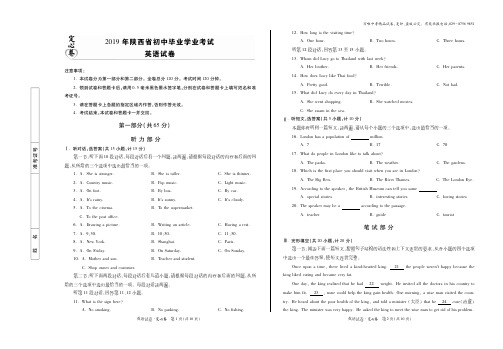
A.TheBigBen.
B.TheRiverThames.
C.TheLondonEye.
19.Accordingtothespeaker,theBritishMuseum cantellyousome .
A.specialstories
B.interestingstories
C.boringstories
D.regret
Ⅳ.阅读理解(共 15小题,计 20分)
第一节:阅读下面一篇短文,判断下列句子是否符合短文内容,符合的用“A”表示,不符合的用
“B”表示。(共 5小题,计 5分)
A
OnthemorningofSeptember2nd,1666,acookandhiswifewerecookingbreakfastfortheirchil
dreninthekitchen.Twobigratsfoughtandknockeddownabottleofoil.Theoilhappenedtoaddtothe
stove(炉).Asaresult,afirewasstarted.
Thecooktriedtoputoutthefire,butitspreadthroughthehousequickly.By8oclock,threehun
B.Teacherandstudent.
C.Shopownerandcustomer.
第二节:听下面两段对话,每段对话后有几道小题,请根据每段对话的内容和后面的问题,从所
给的三个选项中选出最恰当的一项。每段对话读两遍。
听第 11段对话,回答第 11、12小题。
11.Whatisthesignhere?
20.Thespeakermaybea accordingtothepassage.
陕西省西安铁一中2019届九年级一模英语试题(原卷版)
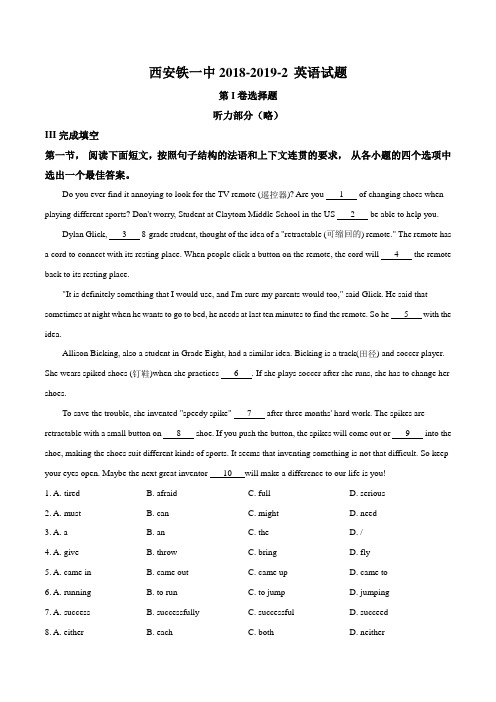
西安铁一中2018-2019-2 英语试题第I卷选择题听力部分(略)III完成填空第一节,阅读下面短文,按照句子结构的法语和上下文连贯的要求,从各小题的四个选项中选出一个最佳答案。
Do you ever find it annoying to look for the TV remote (遥控器)? Are you ___1___ of changing shoes when playing different sports? Don't worry, Student at Claytom Middle School in the US ___2___ be able to help you.Dylan Glick, ___3___ 8-grade student, thought of the idea of a "retractable (可缩回的) remote." The remote has a cord to connect with its resting place. When people click a button on the remote, the cord will ___4___ the remote back to its resting place."It is definitely something that I would use, and I'm sure my parents would too," said Glick. He said that sometimes at night when he wants to go to bed, he needs at last ten minutes to find the remote. So he ___5___ with the idea.Allison Bicking, also a student in Grade Eight, had a similar idea. Bicking is a track(田径) and soccer player. She wears spiked shoes (钉鞋)when she practices ___6___. If she plays soccer after she runs, she has to change her shoes.To save the trouble, she invented "speedy spike" ___7___ after three months' hard work. The spikes are retractable with a small button on ___8___ shoe. If you push the button, the spikes will come out or ___9___ into the shoe, making the shoes suit different kinds of sports. It seems that inventing something is not that difficult. So keep your eyes open. Maybe the next great inventor ___10___will make a difference to our life is you!1. A. tired B. afraid C. full D. serious2. A. must B. can C. might D. need3. A. a B. an C. the D. /4. A. give B. throw C. bring D. fly5. A. came in B. came out C. came up D. came to6. A. running B. to run C. to jump D. jumping7. A. success B. successfully C. successful D. succeed8. A. either B. each C. both D. neither9. A. gone back B. goes back C. go back D. went back10. A. what B. which C. where D. who第二节;阅读下面一篇短文,理解大意,然后从各小题的四个选项中选出最佳答案,使短文连贯。
【6套打包】西安市铁一中学中考一模英语试卷及答案

【6套打包】西安市铁⼀中学中考⼀模英语试卷及答案中考英语第⼀次模拟测试试卷第⼀部分选择题(三⼤题:共38分)⼀、单项填空(共10⼩题,每⼩题0.5分;满分5分)从A、B、C、D中选出可以填⼊空⽩处的最佳选项。
1. Birds have got ____ ability. They can sing.A. aB. anC. theD. (不填)2. I have a ____. My parents control every part of my life.A. questionB. conditionC. decisionD. problem3. —Hi, Paul. Long time no see. What’s new? —I won first prize ____ a writing competition.A. atB. inC. onD. for4. The girl fears to dance in public because she thinks others may____ her.A. hear ofB. wait forC. laugh atD. agree with5. The child kept still ____ she was having a haircut.A. whileB. afterC. beforeD. until6. The man ____ the wallet to the police. He was honest.A.has returnedB. returnsC. will returnD. returned7. Put on more clothes. You ____ feel cold with only a shirt on.A. wouldn’tB. mustC. can’tD. could8. This hill is ____ trees. These trees are home to many animals.A. tired ofB. afraid ofC. full ofD. careful of9.—Oh, I played badly. —____. Just try your best. You’ll do better.A. Don’t worryB. I’m sorryC. All rightD. I’m afraid so6. —Hello! Is that Jenny speaking? —Sorry, I’m afraid you’ve got the wrong ____ .A. addressB. nameC. numberD. message10. You will not believe ____ !A. who did I meet todayB. who I meet todayC. who do I meet todayD. who I met today⼆、完形填空(共15 ⼩题,每⼩题1分;满分15分)阅读短⽂,掌握其⼤意,然后从A、B、C、D中选出可以填⼊空⽩处的最佳选项。
2019中考英语西安(完形填空)练习题(03)及解析.doc
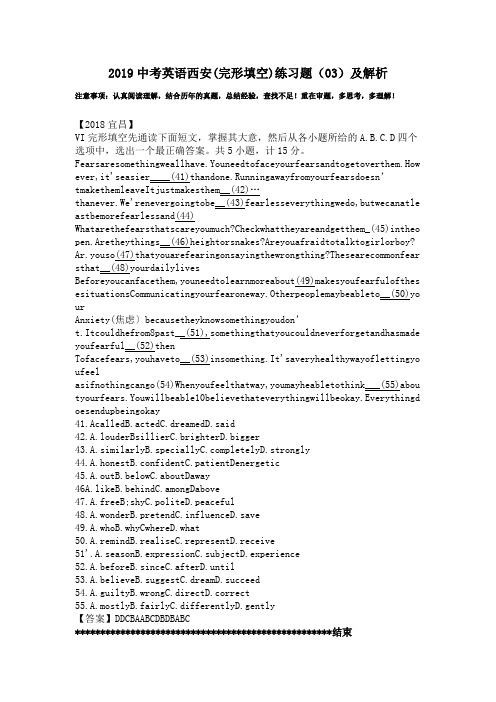
2019中考英语西安(完形填空)练习题(03)及解析注意事项:认真阅读理解,结合历年的真题,总结经验,查找不足!重在审题,多思考,多理解!【2018宜昌】VI完形填空先通读下面短文,掌握其大意,然后从各小题所给的A.B.C.D四个选项中,选出一个最正确答案。
共5小题,计15分。
Fearsaresomethingweallhave.Youneedtofaceyourfearsandtogetoverthem.How ever,it'seasier____(41)thandone.Runningawayfromyourfearsdoesn’tmakethemleaveItjustmakesthem__(42)…thanever.We'renevergoingtobe__(43)fearlesseverythingwedo,butwecanatle astbemorefearlessand(44)Whatarethefearsthatscareyoumuch?Checkwhattheyareandgetthem_(45)intheo pen.Aretheythings__(46)heightorsnakes?Areyouafraidtotalktogirlorboy? Ar.youso(47)thatyouarefearingonsayingthewrongthing?Thesearecommonfear sthat__(48)yourdailylivesBeforeyoucanfacethem,youneedtolearnmoreabout(49)makesyoufearfulofthes esituationsCommunicatingyourfearoneway.Otherpeoplemaybeableto__(50)yo urAnxiety(焦虑〕becausetheyknowsomethingyoudon’t.Itcouldhefrom8past__(51),somethingthatyoucouldneverforgetandhasmade youfearful__(52)thenTofacefears,youhaveto__(53)insomething.It'saveryhealthywayoflettingyo ufeelasifnothingcango(54)Whenyoufeelthatway,youmayheabletothink___(55)abou tyourfears.Youwillbeable10believethateverythingwillbeokay.Everythingd oesendupbeingokay41.AcalledB.actedC.dreamedD.said42.A.louderBsillierC.brighterD.biggerpletelyD.strongly44.A.honestB.confidentC.patientDenergetic45.A.outB.belowC.aboutDaway46A.likeB.behindC.amongDabove47.A.freeB;shyC.politeD.peaceful48.A.wonderB.pretendC.influenceD.save49.A.whoB.whyCwhereD.what50.A.remindB.realiseC.representD.receive51'.A.seasonB.expressionC.subjectD.experience52.A.beforeB.sinceC.afterD.until53.A.believeB.suggestC.dreamD.succeed54.A.guiltyB.wrongC.directD.correct55.A.mostlyB.fairlyC.differentlyD.gently【答案】DDCBAABCDBDBABC***************************************************结束【2017浙江·东阳】完形填空〔此题有15个小题,每题1分,共15分〕阅读下面短文,掌握大意,然后从A、B、C、D四个选项中选出最正确选项。
陕西省西安铁一中2019届九年级一模英语试题(解析版)
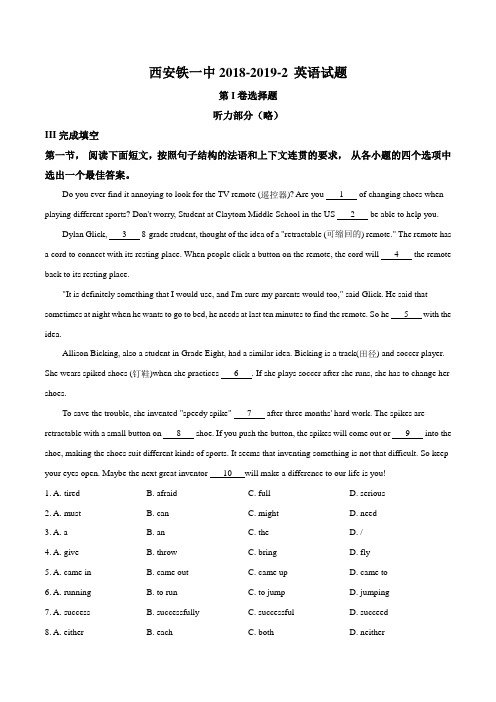
西安铁一中2018-2019-2 英语试题第I卷选择题听力部分(略)III完成填空第一节,阅读下面短文,按照句子结构的法语和上下文连贯的要求,从各小题的四个选项中选出一个最佳答案。
Do you ever find it annoying to look for the TV remote (遥控器)? Are you ___1___ of changing shoes when playing different sports? Don't worry, Student at Claytom Middle School in the US ___2___ be able to help you.Dylan Glick, ___3___ 8-grade student, thought of the idea of a "retractable (可缩回的) remote." The remote has a cord to connect with its resting place. When people click a button on the remote, the cord will ___4___ the remote back to its resting place."It is definitely something that I would use, and I'm sure my parents would too," said Glick. He said that sometimes at night when he wants to go to bed, he needs at last ten minutes to find the remote. So he ___5___ with the idea.Allison Bicking, also a student in Grade Eight, had a similar idea. Bicking is a track(田径) and soccer player. She wears spiked shoes (钉鞋)when she practices ___6___. If she plays soccer after she runs, she has to change her shoes.To save the trouble, she invented "speedy spike" ___7___ after three months' hard work. The spikes are retractable with a small button on ___8___ shoe. If you push the button, the spikes will come out or ___9___ into the shoe, making the shoes suit different kinds of sports. It seems that inventing something is not that difficult. So keep your eyes open. Maybe the next great inventor ___10___will make a difference to our life is you!1. A. tired B. afraid C. full D. serious2. A. must B. can C. might D. need3. A. a B. an C. the D. /4. A. give B. throw C. bring D. fly5. A. came in B. came out C. came up D. came to6. A. running B. to run C. to jump D. jumping7. A. success B. successfully C. successful D. succeed8. A. either B. each C. both D. neither9. A. gone back B. goes back C. go back D. went back10. A. what B. which C. where D. who【答案】1. A 2. A 3. B 4. C 5. C 6. A 7. B 8. B 9. C 10. D【解析】【分析】本文讲述了美国八年级的学生Dylan Glick想出了可缩回的遥控器。
2024届陕西省西安市西安铁一中学中考三模英语试题含答案
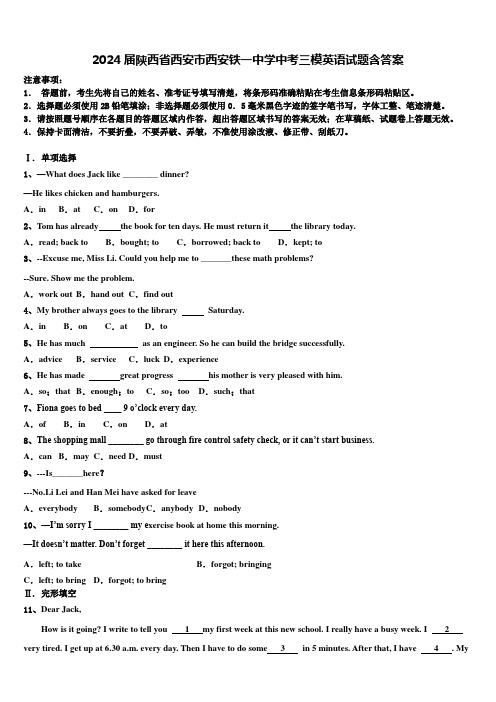
2024届陕西省西安市西安铁一中学中考三模英语试题含答案注意事项:1.答题前,考生先将自己的姓名、准考证号填写清楚,将条形码准确粘贴在考生信息条形码粘贴区。
2.选择题必须使用2B铅笔填涂;非选择题必须使用0.5毫米黑色字迹的签字笔书写,字体工整、笔迹清楚。
3.请按照题号顺序在各题目的答题区域内作答,超出答题区域书写的答案无效;在草稿纸、试题卷上答题无效。
4.保持卡面清洁,不要折叠,不要弄破、弄皱,不准使用涂改液、修正带、刮纸刀。
Ⅰ. 单项选择1、—What does Jack like ________ dinner?—He likes chicken and hamburgers.A.in B.at C.on D.for2、Tom has already the book for ten days. He must return it the library today.A.read; back to B.bought; to C.borrowed; back to D.kept; to3、--Excuse me, Miss Li. Could you help me to _______these math problems?--Sure. Show me the problem.A.work out B.hand out C.find out4、My brother always goes to the library Saturday.A.in B.on C.at D.to5、He has much as an engineer. So he can build the bridge successfully.A.advice B.service C.luck D.experience6、He has made great progress his mother is very pleased with him.A.so;that B.enough;to C.so;too D.such;that7、Fiona goes to bed ____ 9 o’clock every day.A.of B.in C.on D.at8、The shopping mall ________ go through fire control safety check, or it can’t start business.A.can B.may C.need D.must9、---Is_______here?---No.Li Lei and Han Mei have asked for leaveA.everybody B.somebody C.anybody D.nobody10、—I’m sorry I ________ my e xercise book at home this morning.—It doesn’t matter. Don’t forget ________ it here this afternoon.A.left; to take B.forgot; bringingC.left; to bring D.forgot; to bringⅡ. 完形填空11、Dear Jack,How is it going? I write to tell you 1 my first week at this new school. I really have a busy week. I 2 very tired. I get up at 6.30 a.m. every day. Then I have to do some 3 in 5 minutes. After that, I have 4 . Mymother cooks it for me every day. 5 she must get up earlier. My mother is an English teacher in my school, so I go to school with 6 after breakfast. When we get 7 , it is often 7:20. The classes begin at 8:00. We have 8 classes each day, four in the morning and three in the afternoon. We have many subjects at school, and I like all of them. But 9 subjects are very difficult for me, so I have to work hard. After school, I have much homework. This week, I have little time to 10 TV or do sports. I hope things will be better next week.YoursLydia1.A.about B.at C.in2.A.is B.are C.am3.A.cleaning B.sleeping C.shopping4.A.breakfast B.lunch C.supper5.A.or B.because C.so6.A.me B.you C.her7.A.to home B.home C.to school8.A.three B.four C.seven9.A.some B.much C.any10.A.see B.watch C.lookⅢ. 语法填空12、I knew we needed to find that shoe, for our mother couldn’t afford new shoes. I had to go back to find it, so I told my sister to wait right1..A man heard it and stopped me just2.I walked off. He asked me, “You are leaving your sister here to find the shoe? What wo uld you do if she is not here when you return?” I didn’t know how to answer that question. He3., “It’s OK if you can’t find the shoe, but it is not OK to lose your sister.” Then he sent us to mum’s workplace by taxi.During my whole life I have depended on the kindness of many strangers, I feel sorry that I can’t find them and say‘thank you’. I do not even remember what their faces4., but they taught me a lesson --- people are more important than things.Ⅳ. 阅读理解A13、This year 2, 300 teenagers from all over the world will spend about ten months in U.S. homes. They will attend U.S. schools, meet U.S. teenagers, and form impressions (印象) of the real American teenagers. American teenagers will go to other countries to learn new languages and have a new understanding of the rest of the world.Here is a two-way student exchange in action. Fred, nineteen, spent last year in Germany with George's family. Inreturn, George's son, Mike, spent a year in Fred's home in America.Fred, a lively young man, knew little German when he arrived, but after two months' study, the language began to come to him. School was completely different from what he had expected -much harder. Students rose respectfully (尊敬地) when the teacher entered the room. They took fourteen subjects instead of the six that are usual in the United States. There were almost no outside activities.Family life, too, was different. The family's word was law, and all activities were around the family rather than the individual. Fred found the food too simple at first. Also, he missed having a car."Back home, you pick up some friends in a car and go out and have a good time. In Germany, you walk, but you soon learn to like it."At the same time, in America, Mike, a friendly German boy, was also forming his idea. "I suppose I should criticize(批评)American schools." He says. "It is far too easy by our level. But I have to say that I like it very much. In Germany we do nothing but study. Here we take part in many outside activities. I think that maybe your schools are better in training for citizens. There ought to be some middle ground between the two."1.The whole exchange program is mainly to______.A.help teenagers in other countries know the real AmericaB.send students in America to travel in GermanyC.let students learn something about other countriesD.have teenagers learn new languages2.What did Fred and Mike agree on?A.American food tasted better than German food.B.German schools were harder than American schools.C.Americans and Germans were both friendly.D.There were more cars on the streets in America.3.What is particular in American schools?A.There is some middle ground between the two teaching buildings.B.There are a lot of after-school activities.C.Students usually take 14 subjects in all.D.Students go outside to enjoy themselves in a car.4.What did Mike think after experiencing the American school life?A.A better education should include something good from both America and Germany.B.German schools trained students to be better citizens.C.American schools were not as good as German schools.D.The easy life in the American school was more helpful to students.B14、1.Harry thinks the person who handed in the wallet is ____.A.honest B.beautiful C.friendly2.What happened before Harry wrote the note?A.He lost his wallet. B.He received a letter. C.He found a note.C15、China Daily Sept 6, 2016Two days ago China held the G20 Leaders Summit (峰会) in Hangzhou. Leaders of the G20 members not only talked about the world issues, but also had a taste of Chinese culture.The logo of the summit shows Chinese architectural (建筑) culture. The logo looks like a bridge. “I got the idea from the old arched bridges (拱桥) at the West Lake,” said the designer Yuan Youmin. “Bridge link (连接) people and places in many differe nt ways, just as the G20 brings east and west together.”CCTV News Apr 20, 2017China has taken another step toward its goal of putting a space station into orbit around 2022, by sending its first cargo (货物) spacecraft Tianzhou-1 into space on Thursday evening.Atop a Long March-7 Y2 carrier rocket, Tianzhou-1 rose into the air from the Wenchang Space Launch Center in south China's Hainan Province at 7:41 p.m. After about 596 seconds, the spacecraft and rocket successfully separated into orbit.1.Where did the designer get the idea of the bridge logo?A.From the bridges he did before. B.From the old bridges at the West Lake.C.From the old story of the West Lake. D.From G20 Leaders Summit.2.We can tell from the story that the logo of G20 __________.A.shows Chinese culture of painting B.looks like a bridge of western countriesC.stands for a link between east and west D.helps foreign guests know everything about China3.Tianzhou-1 was sent into space successful in __________.A.Hangzhou B.Taiyuan C.Jiuquan D.Hainan4.Which of the followings is NOT true?A.The leaders from twenty countries talked about the world issues.B.The G20 Leaders Summit was started to hold on Sept 4, 2016.C.China first put a space station into orbit on April 20, 2017.D.Tianzhou-1 is a spacecraft with cargo, which was carried by a Long March-7 Y 2.D16、When I was about seven or eight years old, I once went into the barn (马厩) one evening where my dad was doing his daily work. I was surprised to see him wearing his hat backwards. It looked funny.When I asked Dad why he put his hat backwards, he smiled and gave me an explanation. There was a large water tank for the cattle that had to be filled every day. Since it took a long time to finish the work, he would turn the water on and then go about doing other things like cleaning the barn or feeding the cattle, which usually cost him twenty minutes or even more time. The danger, of course, was that if he forgot to turn the water off, the tank would overflow and water would be wasted, which would make a mess.Then he told me the reason why he had his hat turned around. When he finished other work and began to take off his work clothes, he would notice as he removed his hat that the visor (帽舌) was not where it was supposed to be. This would remind him that the water was still running. Then he would go back to the barn and turn it off.I have seen my dad develop many other systems over the years. And I will never forget how helpful and valuable they are. Some may have even been life-saving.Sometimes, people may forget some things. So they will easily make mistake though they may try their best. Using some good methods can help them operate more effectively. In order not to blame others or yourself for mistakes, you’d bette r look for some ways, whether they are funny or not, as long as they will help you in achieving what you truly wish to do. This could be utility, and as simple as a checklist. Now I’ve used a lot of them, such as putting my car keys in the same place every time. It could be having someone check your work and it could also be a computer program that helps to find out whether your calculations are correct.1.The author found his father’s behavior funny because__________.A.he had never been to the barn before B.his father’s hat was different from othersC.the horses played some tricks D.his father wore the hat in a strange way2.What would the author’s father NOT do in the barn according to the passage?A.Clean the barn B.Feed the chickenC.Give food to the cows D.Fill the large water tank3.The word “utility” probably means “__________” in the passage.A.practical B.difficult C.meaningless D.avoidable4.What can we know about the author’s father?A.His job was to develop new systems in the barn.B.The systems he invented were always very useful.C.He developed as many systems as possible to help people.D.He always taught the author how to make proper checklists.5.The best title of the passage could be “__________”.A.My Funny Dad B.Knowledge in BarnC.A Good Cat Can Catch a Healthy Rat D.Keep a Checklist in Your MindE17、Is it true ?1.Wearing the wrong type of glasses will do harm to your eyes .This is not true for adults , although incorrect glasses may not be good for children under 10 . Ready-made glasses , and not wearing when you should , won’ t do harm to your eyes , but you may see better with glasses that are specially made for you .2.Watching too much television is bad for you eyes .This is not true. People with easily affected eyes may find they get red and aching from staring at a fixed distance for long periods , but there won’ t be any lasting effects .3. Carrots will help you see in the dark. Carrots are rich in beta-carotene, which the body can change into vitamin A, too little of which can cause night blindness. However , people in most countries don’ t need to worry about vitamin A deficiency(缺乏), night blindness is more likely to be connected with another vision problem .3.Night blindness is most likely caused by _____ .A.staring for long periods B.too much beta-caroteneC.not enough vitamin A D.vision problems4.According to the article , eye problems can be corrected by _____ .A.wearing specially-made glasses B.performing eye exercisesC.cutting back on television D.eating more carrots5.Watching too much television can cause _____ .A.night blindness B.lasting eye problemsC.a number of vision problems D.eye trouble for a limited time6.The main purpose of this article is to _____ .A.tell people of the importance of their eyesB.tell people how to protect their eyesC.tell people to have more carrotsD.tell people something more about their eyesF18、Many people travel to different places in the world by air. Usually it takes a long time, perhaps half a day, for passengers to stay in the plane. So airlines (航空公司) offer passengers food. But it is common that they feel bad about food taste. Do you agree?To solve this problem, airlines try hard to improve their food. They would like to do so because they don’t want to lose customers.However, according to scientific research, part of the reason why plane food tastes bad is that at high altitude we can not taste things as well as we do on the ground. Also scientists have found that our noses become very dry even before a plane takes off. As the plane moves up, the change in air pressure(压力) reduces one third of the sensibility(感觉) of our taste buds(味蕾). So our taste buds become senseless. The sad fact, however, is that our noses don’t know it.All of these help explain why food on the plane tastes so bad. They also help explain why airlines choose to offer passengers salty and spicy (辛辣的) food. Without doing so, the food would be tasteless.Now there are many researches on this. According to one of them, some volunteers are asked to lie with their feet higher than their heads for weeks. And scientists write down their feelings about food taste.Though scientists try their best, it is not as easy as they thought. Because they can’t deal with the special environment successfully, such as the change in air pressure, making food taste good is still hard for them.1.In Paragraph 2, “this problem” means ________.A.passengers stay long in the plane B.food on the plane tastes badC.passengers have no food to eat D.food on the plane is expensive2.What do airlines do to solve this problem?A.Get more customers. B.Offer more food.C.Improve their food. D.Reduce the ticket price.3.What is the meaning of the underlined phrase “altitude” in the passage?A.above the sea level B.above zeroC.below the sea level D.below zero4.Why do scientists feel it hard to make food on the plane taste good?A.The volunteers don’t know about food taste.B.The volunteers don’t understand them.C.They can’t find enough volunteers.D.They can’t d eal with the special environment successfully.5.What is the best title of the passage?A.Taste of Airplane Food B.Airplane TravelC.Scientific Research on Noses D.The Change in Air PressureⅤ.书面表达19、我们都需要一个健康的环境,但是我们每天都在制造垃圾,环境污染日益恶化,为了人类的生存,我们要从身边小事做起。
(完整版)陕西省2019年英语中考试题及答案解析(版),推荐文档

陕西省初三2019年中考真题英语试卷(带解析)一、单选题(共10小题)1.Everyone likes my father because is friendly.A.his B.himC.he D.himself2.Before you go to Canada, you need to learn more it.A.form B.in C.by D.about3.Many city people their bikes to work every day.A.ride B.will rideC.rode D.have ridden4.We have done much to protect the environment.So the river is getting than before.A.dirtier B.dirtyC.cleaner D.clean5.It’s every policeman’s dream to keep people and the traffic in good order.A.safe B.healthyC.busy D.famous6.--- Look! What’s on the ground?--- Oh, it’s my sweater.Please .A.pick it up B.put it onC.give it out D.take it off7. you smile at others,they will smile back.A.Before B.When C.Until D.Though8.Tourists’ bad behavior by the government in our country from now on.A.will record B.will be recordC.records D.is recorded9.--- Mum, can you tell me ? I dreamed of him last night.--- Next week.A.when my dad comes back B.where my dad goesC.when my dad will come back D.where my dad will go10. on the grass, or it will “city”.A.To walk B.Not to walkC.Walk D.Don’t walk二、完形填空(共1小题)11.阅读下面一篇短文,理解答疑,然后从各小题的四个选项中选出一个最佳答案,使短文连贯完整。
2019中考英语三模测试卷(含答案)
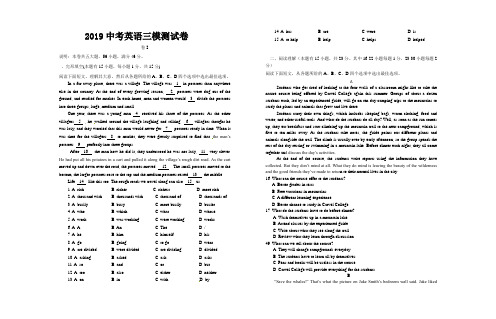
2019中考英语三模测试卷卷I说明:本卷共五大题,56小题,满分46分。
、完形填空(本题有15小题,每小题1分,共15分)阅读下面短文,理解其大意,然后从各题所给的A、B、C、D四个选项中选出最佳选项。
In a far-away place, there was a village. The village was 1 in potatoes than anywhere else in the country. At the end of every growing season, 2 potatoes were dug out of the ground, and readied for market. In each home, men and women would 3 divide the potatoes into three groups, large, medium and small.One year, there was a young man 4 received his share of the potatoes. As the other villagers 5 , he walked around the village laughing and talking. 6 villagers thought he was lazy, and they worried that this man would never get 7 potatoes ready in time. When it was time for the villagers 8 to market, they were greatly surprised to find that the man’s potatoes 9 perfectly into three groups.After 10 the man how he did it, they understood he was not lazy, 11 very clever. He had put all his potatoes in a cart and pulled it along the village’s rough dirt road. As the cart moved up and down over the road, the potatoes moved 12 . The small potatoes moved to the bottom, the larger potatoes rose to the top and the medium potatoes rested 13 the middle.Life 14 like this too. The rough roads we travel along can also 15 us.1. A. rich B. richer C. richest D. more rich2. A. thousand with B. thousands with C. thousand of D. thousands of3. A. busily B. busy C. more busily D. busier4. A. who B. which C. what D. whose5. A. work B. was working C. were working D. works6. A. A B. An C. The D. /7. A. he B. him C. himself D. his8. A. go B. going C. to go D. went9. A. are divided B. were divided C. are dividing D. divided10. A. asking B. asked C. ask D. asks11. A. so B. and C. or D. but12. A. too B. also C. either D. neither13. A. on B. in C. with D. by14. A. has B. are C. were D. is15. A. to help B. help C. helps D. helped二、阅读理解(本题有15小题,共23分。
2019中考英语西安市(完形填空)训练题(03)及解析
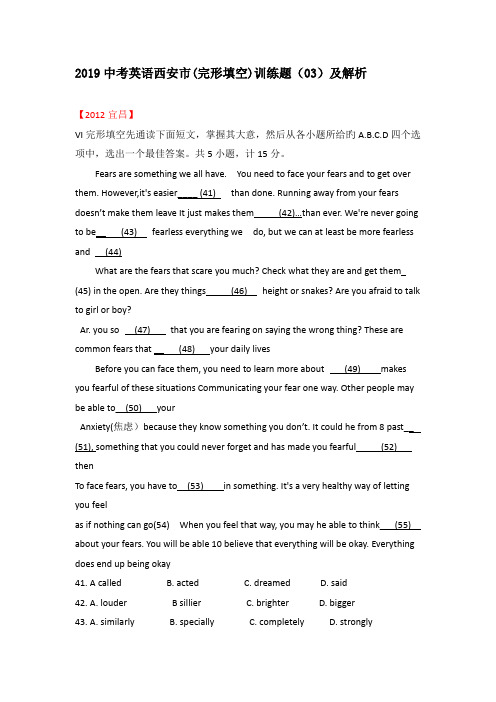
2019中考英语西安市(完形填空)训练题(03)及解析【2012宜昌】VI完形填空先通读下面短文,掌握其大意,然后从各小题所给旳A.B.C.D四个选项中,选出一个最佳答案。
共5小题,计15分。
Fears are something we all have. You need to face your fears and to get over them. However,it's easier____ (41) than done. Running away from your fears doesn’t make them leave It just makes them__ (42)…than ever. We're never going to be__ (43) fearless everything we do, but we can at least be more fearless and (44)What are the fears that scare you much? Check what they are and get them_ (45) in the open. Are they things__ (46) height or snakes? Are you afraid to talk to girl or boy?Ar. you so (47) that you are fearing on saying the wrong thing? These are common fears that __ (48) your daily livesBefore you can face them, you need to learn more about (49) makes you fearful of these situations Communicating your fear one way. Other people may be able to__(50) yourAnxiety(焦虑)because they know something you don’t. It could he from 8 past__ (51), something that you could never forget and has made you fearful__ (52) thenTo face fears, you have to__(53) in something. It's a very healthy way of letting you feelas if nothing can go(54) When you feel that way, you may he able to think___(55) about your fears. You will be able 10 believe that everything will be okay. Everything does end up being okay41. A called B. acted C. dreamed D. said42. A. louder B sillier C. brighter D. bigger43. A. similarly B. specially C. completely D. strongly44. A. honest B. confident C. patient D energetic45. A. out B. below C. about D away46 A. like B. behind C. among D above47. A. free B; shy C. polite D. peaceful48. A. wonder B. pretend C. influence D. save49. A. who B. why C where D. what50. A. remind B. realise C. represent D. receive51'. A. season B. expression C. subject D. experience52. A. before B. since C. after D .until53. A. believe B. suggest C. dream D. succeed54. A. guilty B. wrong C. direct D. correct55. A. mostly B. fairly C. differently D. gently【答案】DDCBA ABCDB DBABC***************************************************结束【2010浙江·东阳】完形填空(本题有15个小题,每小题1分,共15分)阅读下面短文,掌握大意,然后从A、B、C、D四个选项中选出最佳选项。
2019中考英语三模测试卷及答案

2019中考英语三模测试卷及答案说明:本卷共五大题,56小题,满分46分。
、完形填空(本题有15小题,每小题1分,共15分)阅读下面短文,理解其大意,然后从各题所给的A、B、C、D四个选项中选出最佳选项。
A jobless man wanted to apply (求职) for the position of “office boy” at Microsoft. The staff manager interviewed him and then gave him a 1 :clean the floor. The man passed it: he cleaned the floor very well.“You are hired(雇佣),”the manger told the man. “Give me your email address,and I’ll send you the form to 2 .I shall also send you the 3 you should report for the work.”The man replied, “I don’t have a 4 ,or email!”“I am sorry,” said the manager. “If you don’t have email, that means you do not exist(存在).And we cannot 5 person s who do not exist.”The man was very 6 .He didn’t know what to do. He only had 10 dollars with him.Once that was 7 .he wouldn’t have any money to buy even food.He went to the supermarket and bought a box of tomatoes with his 10 dollars. He went from door to door and 8 the tomatoes in small bags.He doubled his money.He 9 this tree times, and returned home with 60 dollars. He realized that he could continue to live this way.He started to go earlier every day,and returned later. He doubled or made even three times his money every day.Soon, he 10 a cart,then a truck.In a very short time, he had his many delivery(递送)trucks.Five years later,the man became one of the most biggest 11 sellers in the country. He started to plan his family’s future. He called an insurance(保险)broker, a man who sells insurance.At the end of the 12 ,the broker ask ed him for his email address. The man replied, “I don’t have en email.”Hearing that, the broker felt very 13 . “You don’t have email,and yet have succeeded in becoming so 14 .Can you imagine what you could have been if you had email?”he said a loud, The man thought for a while,and replied, “an office15 at Microsoft.!”If you just lost your job or just failed an interview, don’t worry,think of the positive(积极的).Good days are on the way and something better will happen to you.1.A.job B.hand C.chance D.test2.A.checked out B.put up C.fill in D.write down B.date C.address D.ticketputer B.screen C.website D.letter5.A.believe B.pay C.accept D.refuse6.A.pleased B.excited C.embarrassed D.disappointed7.A.exchanged B.spent C.wasted D.lost8.A.divided B.showed C.kept D.sold 9.A.repeated B.reminded C.tried D.counted10.A.borrowed B.repaired C.received D.bought11.A.truck B.insurance C.food D.door12.A.introduction B.conversation C.business D.story13.A.worried B.satisfied C.upset D.surprised14.A.clever B.healthy C.rich D.confident15.A.boy B.secretary C.cleaner D.head二、阅读理解(本题有15小题,共23分。
(含五套中考模拟卷)陕西省2019届中考英语一模试卷word版有答案
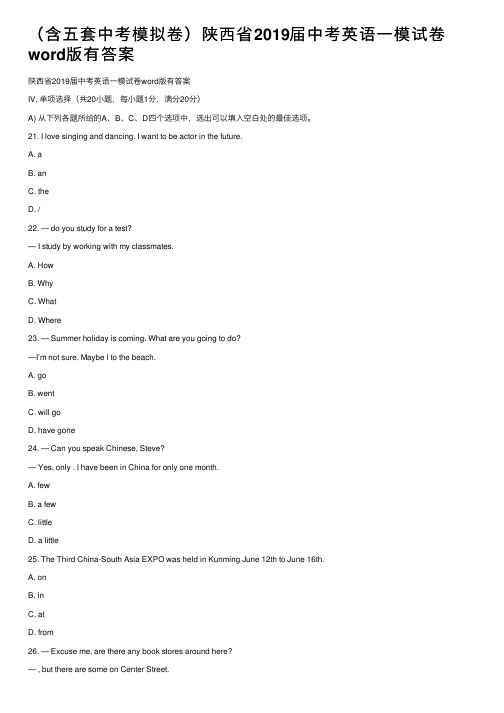
(含五套中考模拟卷)陕西省2019届中考英语⼀模试卷word版有答案陕西省2019届中考英语⼀模试卷word版有答案IV. 单项选择(共20⼩题,每⼩题1分,满分20分)A) 从下列各题所给的A、B、C、D四个选项中,选出可以填⼊空⽩处的最佳选项。
21. I love singing and dancing. I want to be actor in the future.A. aB. anC. theD. /22. — do you study for a test?— I study by working with my classmates.A. HowB. WhyC. WhatD. Where23. — Summer holiday is coming. What are you going to do?—I’m not sure. Maybe I to the beach.A. goB. wentC. will goD. have gone24. — Can you speak Chinese, Steve?— Yes, only . I have been in China for only one month.A. fewB. a fewC. littleD. a little25. The Third China-South Asia EXPO was held in Kunming June 12th to June 16th.A. onB. inC. atD. from26. — Excuse me, are there any book stores around here?A. Yes, there areB. No, there aren’tC. Yes, there isD. No, there isn’t27. You are supposed to be more careful to make fewer while you are writing.A. troubleB. matterC. mistakesD. problems28. WeChat (微信) is very popular. the young the old are getting interested in it.A. Neither…norB. Either…orC. Not only…but alsoD. Between…and29. Mary used to in the countryside, but now she is used to in the city.A. live ; liveB. live ; livingC. living ; liveD. living ; living30. — May I watch TV now, mum?— No, you . You must clean your room first.A. may notB. needn’tC. can’tD. mustn’t31. It’s reported that there are more than 300 smokers in China, nearly a third of all the smokers in the world.A. millionB. millionsC. million ofD. millions of32. useful robot! It can help with the housework like a human servant.A. HowB. What anC. How a33. The volunteers many signs to remind people to protect the environment.A. put onB. put upC. put downD. put off34. —You shouldn’t eat too much junk food. It’s bad for your health.—You’re right. junk food I eat, I will be.A. The less ; the healthierB. The less ; the healthyC. The more ; the healthierD. The more ; the healthy35. — I wonder at 6:00 yesterday afternoon.— I was doing my homework in the reading room.A. what were you doingB. what did you doC. what you were doingD. what you are doingB) 在下列各题的选题中选择⼀个与句⼦划线部分意思相同或相近的最佳答案。
2019-2020学年铁一9上期中英语含答案(4)
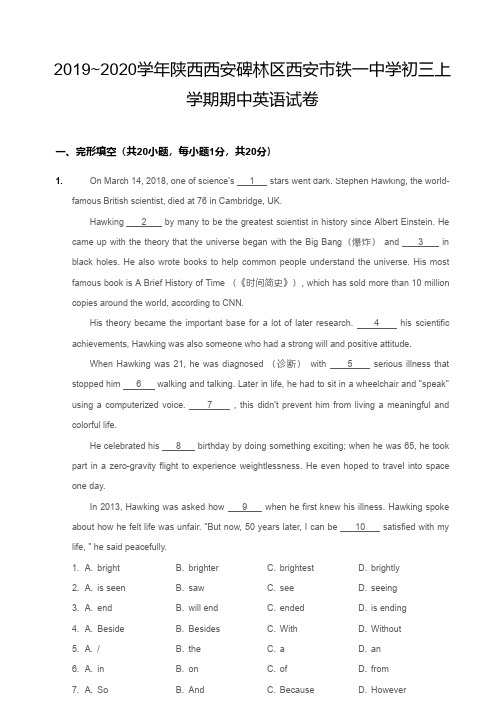
2019~2020学年陕西西安碑林区西安市铁一中学初三上学期期中英语试卷一、完形填空(共20小题,每小题1分,共20分)1.1.2.3.4.5.6.On March 14, 2018, one of science's 1 stars went dark.Stephen Hawking, the world-famous British scientist, died at 76 in Cambridge, UK.Hawking 2 by many to be the greatest scientist in history since Albert Einstein. He came up with the theory that the universe began with the Big Bang(爆炸) and 3 in black holes. He also wrote books to help common people understand the universe. His most famous book is A Brief History of Time (《时间简史》), which has sold more than 10 million copies around the world, according to CNN.His theory became the important base for a lot of later research. 4 his scientific achievements, Hawking was also someone who had a strong will and positive attitude.When Hawking was 21, he was diagnosed (诊断)with 5 serious illness that stopped him 6 walking and talking. Later in life, he had to sit in a wheelchair and "speak" using a computerized voice. 7 , this didn't prevent him from living a meaningful and colorful life.He celebrated his 8 birthday by doing something exciting; when he was 65, he took part in a zero-gravity flight to experience weightlessness. He even hoped to travel into space one day.In 2013, Hawking was asked how 9 when he first knew his illness. Hawking spoke about how he felt life was unfair. "But now, 50 years later, I can be 10 satisfied with my life, " he said peacefully.A.brightB.brighterC.brightestD.brightlyA.is seenB.sawC.seeD.seeingA.endB.will endC.endedD.is endingA.BesideB.BesidesC.WithD.WithoutA./B.theC.aD.anA.inB.onC.ofD.from8. 9.10.A.60 B.60th C.the 60th D.the 60A.he felt about hislifeB.he feels about hislifeC.did he feel abouthis lifeD.does he about hislifeA.quietB.quietlyC.quickD.quickly2.1.2.3.4.5.6.7.8.9.10.One day, a student asked his teacher, "What is greed(贪婪)" The teacher didn't answerhis question directly. 1 , he asked the student to walk through the chocolate bar next to their school and pick up the biggest chocolate bar he 2 find. But there was a rule: Once he passed through the factory, he could not turn back.The student went into the chocolate factory. 3 he walked, he saw a large chocolate bar. He liked it, but he thought he might be able to find even bigger ones if he kept going. He kept walking and saw another chocolate bar. This one was a little smaller. But again, he thought he could find an even bigger one if he kept going.As he walked near the 4 of the factory, he saw fewer chocolate bars. What's worse, none of them were as 5 as the earlier ones. He started to regret his 6 to keep going.7 he gave up. He went back to his teacher empty-handed and explained what hadhappened. The teacher told him, "You liked the first chocolate bar, but you kept 8 a bigger one. And later, you 9 that you had given up the biggest chocolate bar because you thought you could find a bigger one. That 10 greed."A.InsteadB.Instead ofC.HoweverD.ThenA.shouldB.needC.couldD.canA.BeforeB.UntilC.WhenD.SinceA.beginningB.endC.placeD.homergeB.deepC.longD.wideA.decisionB.purposeC.orderD.problemA.SuddenlyB.FinallyC.EspeciallyD.LuckilyA.paying forB.waiting forC.asking forD.looking forA.daredB.interviewedC.changedD.realizedA.callsB.is calledC.was calledD.called二、阅读理解(共15小题,共20分)3.1. 2. 3. 4. 5.Tea is the most popular drink in the world besides water. There are thousands of differenttypes of tea. All tea comes from the tea plant. The leaves of this plant are picked several timesa year, usually by hand. After it has been picked, the tea is processed into black tea, oolongtea(乌龙茶), green tea or white tea.◆Green tea is the best choice for office workers.People who always work in places with air conditioning may face skin(皮肤)problems such as easily dry skin. Among all the drinks, green tea is the best choice. Because there are important things in green tea. Moreover, drinking more green tea can prevent computer radiation(辐射).◆Winter is the season to drink black tea.Chinese medicine believes that different people should drink different tea according to the different characteristics and tastes of each kind of tea. Black tea has some advantaged(优势), such as warming the stomach and quickening(加快)digestion(消化). So drinking warm black tea in the cold winter is a most suitable choice.◆Do not drink strong tea.Strong tea may make the body far too excited and can have a bad influence on the cardiovascular(心血管的)system(系统)as well as the nervous system. For a person who has problems with these parts, to drink too much strong tea may cause heart and blood pressure illness, or even make the old illnesses much worse.◆Do not drink too much tea when you are eating.Drinking too much tea or strong tea may not be good for taking in many constant elements and trace elements(常量元素和微量元素). Also, people should not drink tea with milk or other milky food.The leaves of the tea plant are picked once a year.Drinking black tea can help warm the stomach.If people always work with the computer, they should drink black tea.You'd better avoid drinking strong tea if you have heart and blood pressure illness.This passage tells us how to drink tea correctly.4.Dogs help people and protect our homes. Now, dogs have another new job—findendangered animals! This kind of dog is called conservation detection dog(保护探测犬). The aim of their job is to find endangered animals.A.had saved other animals beforeB.grew up in the wild togetherC.aren't good at finding the frogsD.work well in finding the frogs(1)A.interesting B.difficult C.skilled D.boring(2)A.It always remains silent.B.It has dark body color.C.It's not easy to find.D.Its size is small.(3)Andy is a dog owner and trainer. He is training two border collies ( 边境牧羊犬), namedRuby and Uda, to become conservation detection dogs. Recently, the dogs went on their job about finding the Baw Baw frog—one of Australia's most endangered animals. It is an arduous job. Just to get to the place, where the frogs live, the dogs and their trainers must walk far distances through forests.But it is important. A deadly thing has killed nearly all of Australia's Baw Baw frogs. In fact,scientists say this frog could disappear in the next five to ten years. Zoos Victoria is a group set up to protect wildlife.Gilbert is a frog expert at Zoos Victoria. He says detecting the frogs in the wild can be verydifficult because they mainly live underground. The females (女性) are even more difficult to find. They unlike the male Baw Baw frogs, do not have a call. He adds that the dogs Ruby and Uda had no trouble finding the frogs.Zoo Victoria in Australia is now considering using trained dogs to find other endangeredanimals. Experts say detection dogs may have a really important role to play.From the article we know Ruby and Uda .The underlined word "arduous "" in Paragraph 4 means .Why is the work of finding the female Baw Baw frog so difficult?5.CWhat do you do with an empty bottle? Will you throw it into one trash bin? Actually , thecap, the wrapper (包装纸) and the bottle itself have to go into three different bins.Garbage sorting is a big problem worldwide, In recent years, some Chinese cities havebeen working hard on it.Shanghai has worked with Alipay to create a "green account (账户)" service for itsresidents (居民). Account holders get scores by correctly sorting their garbage. Through the Alipay app, they can exchange the points for small gifts and even some money. The city is asking all of its residents to sort their garbage into four groups: wet, recyclable (可回收的),harmful and dry.A.B.C.D.(1)A.A lot of money.B.Some small gifts.C.A computer.D.A car.(2)A.Batteries. B.Glasses. C.Leftover food. D.Medicine.(3)Wet waste is also known as household waste. "They are things you don't want but that pigscan eat, " Guangzhou Daily explained.Paper, metal (金属), glass and other things that can be reused are recyclable waste.Harmful waste includes things like medicine, batteries and fluorescent bulbs (荧光灯泡).Finally, any waste that's not wet, recyclable or harmful will go in the "dry waste" bin.Many other Chinese cities are also using this method to sort their garbage. For example,Shenzhen has been sorting its garbage into the same four groups since 2012. Students there also receive waste-sorting guidebooks that they must study.China is improving its waste-sorting efforts. There is still a long way to go. But it's never toolate to learn how to sort your trash properly and protect the environment.How is Shanghai encouraging people to sort their garbage?Creating a "green account" service with the help of Alipay.Paying people to sort their trash correctly.Allowing people to exchange garbage with each other.Providing its residents with guidebooks to help them.What will people in Shanghai probably get with the scores they get?Which of the following would be classified as wet waste?6.When we see babies or pets, we can't help touching them to show our love. And they giveus happy feelings back. But a recent study shows that it's different for plants.A study, published in The Plant Journal, shows that plants don't like to be touched. That'sbecause touching changes their genus (基因), and even worse, can slow their growth.Professor Jim Whelan in Australia gave an explanation. The lightest touch from a human, an animal, an insect, or even plants touching each other in the wind, leads to a huge gene change in the plant.In order to test the theory, the scientists did an experiment (实验)on plants. They grew anumber of plants for four weeks. Then they touched them with a paintbrush every 12 hours.They found that as the result of the touch, the mitochondria (线粒体) in the plants had beenA.loveB.touchC.waterD.weather(1)A.By providing energy for cells.B.By changing the plants' genes.C.By fighting against the insects.D.By reducing the number of cells.(2)A.B.C.D.(3)A.B.C.D.(4)partly destroyed. The mitochondria are the "power-house" of the cell (细胞)which produce energy for the cells in both animals and plants. If this "power-house" is weakened, the plants will lose plenty of energy that should have helped their growth.Whelan further explained, "If the touching is repeated, then plant growth is reduced by 30percent." Touching changes the plants, but it's not always a bad change. Continually touching or moving plants will make them grow shorter than others. However, in some ways, this change could be helpful. It may help plants fight threats to their health such as insects and bad weather.The new findings have led to a deeper understanding of the plants. And the research mighthelp with the growth of plants.According to the article, can get in the way of plants' growth.How do the mitochondria help the plants' growth?The scientists did the experiment to .explain why pets love to be touchedfind out why some plants grow more slowlytest if touching can change the genes of plantsshow that plants' and animals' genes are differentThe best title of this passage is .Touching has a bad influence on plantsNew researches on plants and animalsTouching is good for plantsTouching changes the plants' genes 三、完成句子(共10小题,每小题1分,共10分)7.王老师总是鼓励我们通过努力实现我们的梦想。
铁一中滨河分校中考英语模拟三
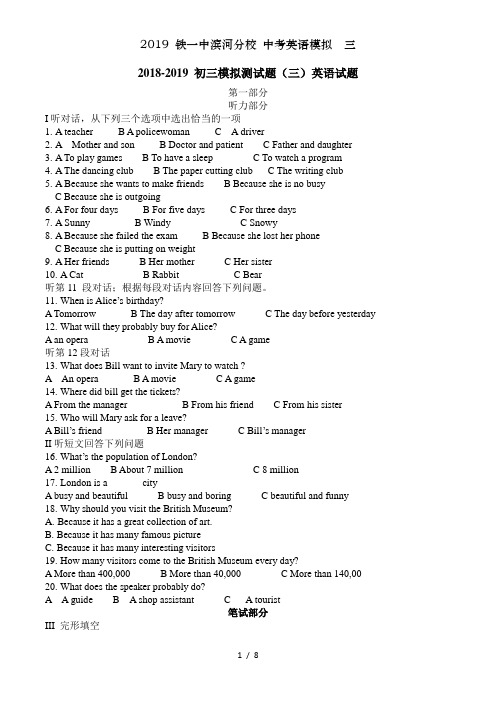
2018-2019 初三模拟测试题(三)英语试题第一部分听力部分I听对话,从下列三个选项中选出恰当的一项1.A teacher B A policewoman C A driver2.A Mother and son B Doctor and patient C Father and daughter3.A To play games B To have a sleep C To watch a program4.A The dancing club B The paper cutting club C The writing club5.A Because she wants to make friends B Because she is no busyC Because she is outgoing6.A For four days B For five days C For three days7.A Sunny B Windy C Snowy8.A Because she failed the exam B Because she lost her phoneC Because she is putting on weight9.A Her friends B Her mother C Her sister10.A Cat B Rabbit C Bear听第11 段对话;根据每段对话内容回答下列问题。
11.When is Alice’s birthday?A TomorrowB The day after tomorrowC The day before yesterday12.What will they probably buy for Alice?A an operaB A movieC A game听第12段对话13.What does Bill want to invite Mary to watch ?A An operaB A movieC A game14.Where did bill get the tickets?A From the managerB From his friendC From his sister15.Who will Mary ask for a leave?A Bill’s friendB Her managerC Bill’s managerII听短文回答下列问题16.What’s the population of London?A 2 millionB About 7 millionC 8 million17.London is a ______ cityA busy and beautifulB busy and boringC beautiful and funny18.Why should you visit the British Museum?A.Because it has a great collection of art.B.Because it has many famous pictureC.Because it has many interesting visitors19.How many visitors come to the British Museum every day?A More than 400,000B More than 40,000C More than 140,0020.What does the speaker probably do?A A guideB A shop assistantC A tourist笔试部分III 完形填空AShe could have lived ___21___ easy comfortable life. But instead she chose to work hard and care for the sick.Florence Nightingale was one of the ___22___ greatest nurses. Every year on her birthday, May 12, people celebrate International Nurses Day to remember the love and help ___23____ she gave to so many people.Nightingale was born into a rich family in 1820 in Italy. When she was 24, she told her parents she wanted to be a nurse ____24____ they didn’t like that idea. The family had a lot of money, so they thought it would be ____25_____ if she didn’t work. But Nightingale went on with her dreams. She went to Germany to learn to be a nurse.During the war in 1854, Nightingale and a team of 38 nurses from England went to ___26___ soldier near Turkey. She made the hospital there much cleaner.At night, she would look after the soldiers. She carried a lamp with her, and the soldiers began to call her “The Lady ___27____ the Lamp.”In 1860, after the war, Nightingale _____28___ the first nursing school. She also worked to make the hospitals better and make ____29___ for nurse. She died in 1910 in London, at the age of __30____.Nightingale’s birthday became International Nurses Day in 1974.21.A the B a C an D /22.A city’s B hospital’s C country’s D world’s23.A Who B what C that D which24.A And B Or C But D Although25.A good B well C best D better26.A look for B wait for C ask for D care for27.A in B to C or D with28.A open B opens C opened D had opened29.A plans B suggestions C decisions D rules30.A ninty B ninety C ninty-one D ninety-oneBIt can be dangerous to travel by sea. Ships sometimes sink far away for land. When this happens, the sailors have to get into small boats. If another ship ___31___ and help them and they do not have enough food or water, they may die.Most people believe we must not drink sea water. They believe that if we ____32__, we shall be very ill ___33___ the salt in the water. A doctor called Alan Bombard did not believe this. He thought that people ____34___ stay alive by drinking sea water and eating small fish, animals, and plants from the sea. On 19 October 1953, he set out in a small boat to ___35___ the Atlantic Ocean. He did not take any food or water with him.Every day Dr. Bombard drank just a little sea water. He also caught fish and they had water in them. He drank this water. He could not cook the fish, so he ate them ____36__ they were. He took small plants from the sea, ___37___ gave him more food.Dr. Bombard became ____38____, tired and quite ill, but after 65 days at sea, he was still alive. He traveled 2750 miles from one side of the Atlantic Ocean to the other, and on 24 December 1953, he reached Barbados.He _____39___ 20 kilo, but he showed that people could live ___40____ sea water and animalsand plants in the sea.31.A not come B does not come C won’t come D isn’t coming32.A do B drink C have D will do33.A because B as C while D because of34.A could B can C will D had35.A across B crossing C cross D through36.A with B when C as D for37.A who B which C those D what38.A thin B fat C cool D healthy39.A got B made C lost D had40.A on B about C with D inIV阅读理解AButterflies are common all over the world, but butterflies in hotter countries are usually bigger and more brightly colored than those in coo1er countries,and there are more different kinds.Usually the male butterflies are more brightly colored than the females.The females have bigger and heavier bodies since they carry the eggs.The bright colors of the males help to attract the females,and the duller(暗)colors of the females make them less likely to be caught by enemies before they have laid their eggs.Some butterflies have bright pattern colors on the upper surface of their wings that show when flying,but when they rest on a tree or leaves,they close their wings.On the undersides of their wings there are green and brown marks which look like the tree or leaves.They are then difficult to be seen.The best example of this is the Dead Leaf Butterfly.When its wings are c1osed,it looks exactly like a dead leaf.There are even marks that look like the holes in a dead leaf.When the butterfly is run after by a bird,it closes its wings and seems to have disappeared completely.Many butterflies have round marks on their wings that look like eyes.The round marks have a useful function(功能).When the butterflies are resting,their wings are closed,and these marks can't be seen.When a bird sees one,and begins to attack it,the butterfly will open its Wings.The bird thinks that it sees two eyes staring at it,frightened,and flies away.41.Butterflies in hotter countries are usually bigger and more brightly colored than those in cooler countries, but there are less different kinds.42.The color of male butterflies are usually brighter than the female43.The duller colors of the females butterflies help to attract the males44.When run after by a bird, the Dead Leaf Butterfly opens its wings to frighten the bird away.45.Many butterflies have round marks on their wings and they just look like eyes.BWhen we have small cuts in the skin, something strange may happen. The cuts are able to heal themselves in a couple of days. How does this happen? Read on, and you will find out the secret.Every living thing on the earth is made up of cells(细胞). Cells grow and make new cells. Most cells are very small and we can't see them with our eyes. Different cells have different uses. Our skin cells are special ones. The cells on the outside of our skin are old dead cells. New skin cells are right under the outside. These are the living skin cells. They work for our bodies. They help protect our bodies and heal cuts.Our bodies make skin cells all the time. As the old cells fall off, new cells grow in the same place. Each person makes about 18 kg of skin cells during his or her life. Outside skin cells fit together closely with no gaps between them. When you cut yourself, you can harm your skin cells. A small cut will not be harmful. Your skin will quickly heal itself by making new skin cells. How do skin cells work? First, the cells near the cut get bigger and move into the gap. Next, these bigger cells meet in the middle. They form a new layer(层) of skin cells. Finally, new cells will grow until the gap disappears. In this way, your skin can grow and get well itself. How amazing the small cells are! Next time you have a cut, don't worry about it. Maybe in a few days, you will be surprised to find it healed.46.From the passage, we know that cells______.A.are large and we can see them with our eyes B.can heal few cuts themselvesC.are in everything on the earth D.can grow and make new cells47. Skin cells heal cuts in three steps. ______is the right order.48 .Which of the following is TRUE according to the passage?A.Each person can make 18 kg of skin cells every day.B.Different cells have different uses in our bodies.C.The skin cells have little work to do in the body.D.Every living thing on the earth is made up of skin cellsCMany people travel to different places in the world by air. Usually it takes a long time perhaps half a day, for passengers to stay in the plane. So airlines offer passengers good. But it is common that they feel bad about food taste. Do you agree?To solve this problem, airlines try hard to improve their food. They would like to do so because they don’t want to lose customers.However, according to scientific research, part of the reason why plane food tastes bad is that at high altitude(海拔)we can not taste things as well as we do on the ground. Also scientists have found that our noses become very dry even before a plane takes off. As the plane moves up, the change in air pressure(气压)reduces one third of the sensibility(感觉)of our taste buds(味蕾). So our taste buds become senseless. The sad face, however, is that our noses don’t know it.All of these help explain why food on the plane tastes so bad. They also help explain why airlines choose to offer passengers salty and spicy food. Without doing so, the food would be tasteless.Now there are many researches on this. According to one of them, some volunteers are asked to lie with their feet higher than their heads for weeks. And scientists write down their feelings about food taste.Though scientists try their best, it is not as easy as they thought. Because they can’t deal with the special environment successfully, such as the change in air pressure, making food taste good is still hard for them.49.In Paragraph 2, “this problem”means ______.A. passengers stay long in the planeB. food on the plane tastes badC. passengers have no food to eatD. food on the plane is expensive50.What do airlines do to solve this problem?A. Get more customers.B. Offer more food.C. Improve their food.D. Reduce the ticket price.51.Why do scientists feel it hard to made food on the plane taste good?A. The volunteers don’t know about food taste.B. The volunteers don’t understand them.C. They can’t find enough volunteers.D. They can’t deal with the special environment successfully.52.What is the best title of the passage?A. Taste of Airplane FoodB. Airplane TravelC. Scientific Research on NosesD. The Change in Air PressureDPopular breakfast foods in the United States, as in many other countries around the world, include coffee, milk, juice, eggs and bread. Some other breakfast items served in the United States are thought to be traditional American. However, they actually come from other countries.A very popular breakfast food in America is the pancake--- a thin , flat cake made out of flour and often served with maple syrup. The idea of the pancake is very old. In fact, pancakes were made long ago in ancient China.Bagels, a round thick bread with a hole in the middle , are also popular for breakfast in America. Polish people in the late 1600s came up with the idea for the first bagels and this new kind of bread soon took off across Eastern Europe.In the late 1800s, thousands of Jews from Eastern Europe travelled to the United States and brought the recipe for bagels with them. Today, New York bagels are said to be the best in the world. Many people have them with cream for breakfast on the go.Doughnuts (usually spelled “donut” in the United States) came from France. They were served to American soldiers in France in the World War I. After the war, American soldiers asked cooks in the United States to make doughnuts for them. Now , served with coffee, they are a very popular breakfast food across the United States.53:Which sentence is true for both bagels and donuts?A.They both came from Europe B.They are both easy to makeC.They are both sweet D.people in New York make them best54:Who brought bagels to America?A.Polish people B.Jewish People C.A Chinese People D.American soldiers55.This passage is mainly about _______A famous places in the United States to eat breakfast.B popular American breakfast goods coming from ChinaC the most popular types of pancakes in the United StatesD the history of popular breakfast goods in the United States第二部分V完成句子56.一些科学家们相信在未来将会有更多的机器人Some scientists believe that there ________________ more robots in the future.57.那加工厂仍然把污水倒进附近的河里The factory is still _________waste water ________ the river nearby.58.为什么不请吴老师帮助我们呢?Why not ____________ Mr. Wu __________ help us?59.我记得告诉过他这个消息I _________________________ him the new.60.对于我们青少年来说,接受教育更重要For our teen, ____________________ is more important.VI 短文填空strong;thank; support; hand; break; friend; secret;except; final; heWhen I was a child, my father had to do three jobs for a family of seven. Every time I saw him come back late, looking tired, I promise myself that someday I would show my 61________ to my father for what he had down.Over the next twenty years, my father worked hard to 62_______our big family and suffered a lot from a heart problem. One morning, my father’s old car 63_______ down and he asked me to pick him up after his medical examination. He had 64_________ refused when I offered to replace (取代) his old car. He said that he did not want something that he couldn’t pay himself.As he stepped out of the doctor’s office, he looked unusually 65_________. We drove in silence and he made me promise to keep the medical report 66________. I did this with a heavy heart.At that time, I was 67_________a new car. I asked my father to go with me to pick one out. When I started talking with the salesman, I noticed my father admiring a brown car. I 68________chose a white car. My father took one final look at the brown car and seemed kind of sorry before leaving. I heard him muttering (嘀咕) to 69________, “I really like that car. I wish I could afford it.”Several days later, I asked my father if he could go with me to pick up my new car. As we arrived, the salesman 70_________him a key to a new car - the brown one - and explained that it was for him, from me. My father looked at me in great surprise. I explained it was my childhood promise and smiled at this man, who had given up everything for his family.VII 任务型阅读You either have it, or you don’t -- a sense of direction. But why is it that some people could find their way across the Sahara without a map while others can lose themselves in the next street?Scientists say we're all born with a sense of direction, but it is not properly understood how it works. One theory is that people with a good sense of direction have simply worked harder at developing it. Research being carried out at Liverpool University supports this idea and suggests that if we don't use it, we lose it."Children as young as seven have the ability to find their way around," says Jim Martland, Research Director of the project. "However, if they are not allowed out alone or are taken everywhere by car, they never develop the skills."Jim Martland also says that young people should be taught certain skills to improve their sense of direction. He makes the following suggestions: .●If you are using a map, tum it so it connects with the way you are facing.●If you leave your bike in a strange place, put it near something like a big stone or a tree. Notelandmarks on the route as you go away from your bike. When you return, go back along the same route.●Simplify the way of fin ding your direction by using lines such as streets in a town, streams, or walls in the countryside to guide you. Count your steps so that you know how far you have gone and note any landmarks to help you. Now you need never get lost again!71.When do children have the ability to find the way around?When they are __________ years old72.Why do we turn the map if we are using?Because it _________________73 what can be used as landmarks according to Jim Martlands’s suggestions?___________________ can be used as landmarks according to Jim Martland’s suggestions74 How can we simplify the way for finding the direction?Through ___________________________75.What’s the main idea of this passage?The writer tries to _____________________VIII补全对话A(Alice advises Bill to read English every day and agree to help him )A: why don’t you look happy?B: Because I have a lot of trouble with my English.I can hardly pass the exam every time 76____________________A: Don’t worry. 77_____________________________________B: No, I only read English before the exam.A: Ah, that’s it .If you want to study it well, you must practice it every day 78 _________________ B: It’ll take your advice and try to practice reading English every day 79______________________ A: All right. I’d like to. But in fact I still have some trouble with English too 80 ____________Andy: My friend Gina invited me to her birthday 81___________________________________? Bill: How about an album?Andy: 82_____________________________. how much is an album?Bill : It’s at least 80 dollars.Andy: 83 ____________________________. I don’t have enough money for it.Bill: Oh 84_______________________________________________?Andy: No, no. She doesn’t like cats.Bill: I see. What about a scarf?Andy: 85__________________________________________.Bill:Does she like flowers? Maybe flowers are wonderful.Andy: Great! I will buy some for her. Thanks for your adviceIX书面表达近些年来,我们赖以生存的环境日益恶化。
精编2019级陕西省中考英语模拟试题(有标准答案)(Word版)
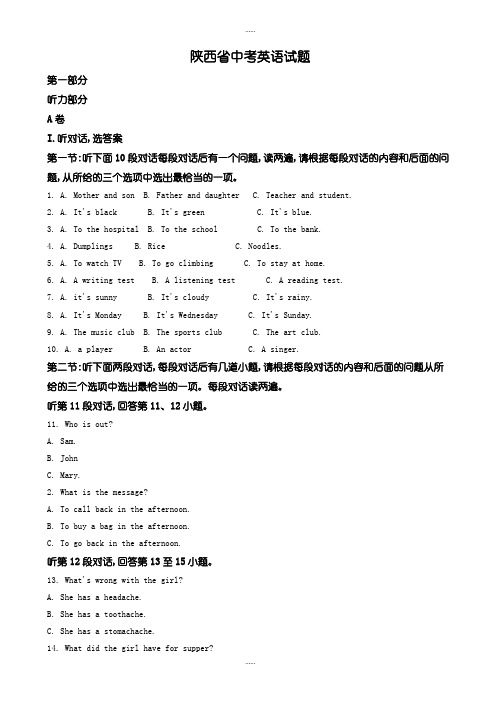
陕西省中考英语试题第一部分听力部分A卷I.听对话,选答案第一节:听下面10段对话每段对话后有一个问题,读两遍,请根据每段对话的内容和后面的问题,从所给的三个选项中选出最恰当的一项。
1. A. Mother and son B. Father and daughter C. Teacher and student.2. A. It's black B. It's green C. It's blue.3. A. To the hospital B. To the school C. To the bank.4. A. Dumplings B. Rice C. Noodles.5. A. To watch TV B. To go climbing C. To stay at home.6. A. A writing test B. A listening test C. A reading test.7. A. it's sunny B. It's cloudy C. It's rainy.8. A. It's Monday B. It's Wednesday C. It's Sunday.9. A. The music club B. The sports club C. The art club.10. A. a player B. An actor C. A singer.第二节:听下面两段对话,每段对话后有几道小题,请根据每段对话的内容和后面的问题从所给的三个选项中选出最恰当的一项。
每段对话读两遍。
听第11段对话,回答第11、12小题。
11. Who is out?A. Sam.B. JohnC. Mary.2. What is the message?A. To call back in the afternoon.B. To buy a bag in the afternoon.C. To go back in the afternoon.听第12段对话,回答第13至15小题。
2019中考英语西安市(完形填空)训练题(03)及解析
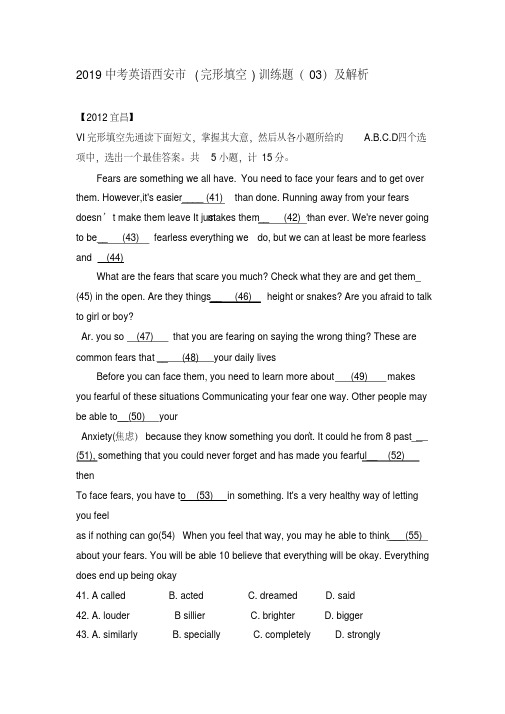
2019中考英语西安市(完形填空)训练题(03)及解析【2012宜昌】VI完形填空先通读下面短文,掌握其大意,然后从各小题所给旳 A.B.C.D四个选项中,选出一个最佳答案。
共5小题,计15分。
Fears are something we all have. You need to face your fears and to get over them. However,it's easier____ (41) than done. Running away from your fearsmakes them__ (42)…than ever. We're never going doesn’t make them leave It justto be__ (43) fearless everything we do, but we can at least be more fearless and (44)What are the fears that scare you much? Check what they are and get them_ (45) in the open. Are they things__ (46) height or snakes? Are you afraid to talk to girl or boy?Ar. you so (47) that you are fearing on saying the wrong thing? These are common fears that __ (48) your daily livesBefore you can face them, you need to learn more about (49) makes you fearful of these situations Communicating your fear one way. Other people may be able to__(50) yourAnxiety(焦虑)because they know something you don’t. It could he from 8 past__ (51), something that you could never forget and has made you fearful__ (52)thenTo face fears, you have to__(53) in something. It's a very healthy way of letting you feelas if nothing can go(54) When you feel that way, you may he able to think___(55) about your fears. You will be able 10 believe that everything will be okay. Everything does end up being okay41. A called B. acted C. dreamed D. said42. A. louder B sillier C. brighter D. bigger43. A. similarly B. specially C. completely D. strongly44. A. honest B. confident C. patient D energetic45. A. out B. below C. about D away46 A. like B. behind C. among D above47. A. free B; shy C. polite D. peaceful48. A. wonder B. pretend C. influence D. save49. A. who B. why C where D. what50. A. remind B. realise C. represent D. receive51'. A. season B. expression C. subject D. experience52. A. before B. since C. after D .until53. A. believe B. suggest C. dream D. succeed54. A. guilty B. wrong C. direct D. correct55. A. mostly B. fairly C. differently D. gently【答案】DDCBA ABCDB DBABC***************************************************结束【2010浙江·东阳】完形填空(本题有15个小题,每小题1分,共15分)阅读下面短文,掌握大意,然后从A、B、C、D四个选项中选出最佳选项。
- 1、下载文档前请自行甄别文档内容的完整性,平台不提供额外的编辑、内容补充、找答案等附加服务。
- 2、"仅部分预览"的文档,不可在线预览部分如存在完整性等问题,可反馈申请退款(可完整预览的文档不适用该条件!)。
- 3、如文档侵犯您的权益,请联系客服反馈,我们会尽快为您处理(人工客服工作时间:9:00-18:30)。
2018-2019-2 英语试卷第I卷(共65分)听力部分I。
听对话,选答案。
(共15小题,计15分)第一节:本题共有10个小题,每个小题你将听到一段对话和一个问题,读两遍,请根据每段对话的内容和后面的问题,从所给的三个选项中选出最恰当的一项。
1. A. He has a cold. B. He has fever C. He has a headache.2. A. His father B. His sister C. His mother3. A.English. B. Math. C. Chinese.4. A.A purse B. A book. C .A phone.5. A. To France. B. To Australia. C. To Canada.6. A On foot. B.By bus C. By bike.7. A. To jump. B To draw C. To run.8. A Twice a week. B.Every day. C. Twice a month9. A. A doctor B. A teacher. C. A singer.10.A.It's 6:15. B. It’s 6: 20. C. It's 6: 30第二节:听下面两段对话,每段对话后有几个问题,请根据每段对话的内容和后面的问题,从所给的三个选项中选出最恰当的一项。
每段对话读两遍。
听第11段对话,回答第11、12小题.11. What's the girl going to buy at the bookstore?A. An English storybook.B. Several books on physics.C. An English dictionary.12. Where will they meet?A. At the No.16 bus stop.B. At the No. 60 bus stop. C .At the No.6 bus stop.听第12段对话,回答第13至15小题.13.Who is calling?A.Mike.B.Gina.C. Nancy.14. Where will Mike have a party?A. In his new officeB. In a new park.C. In his new house.15.How long will the party last?A. Three hours.B. Two hours.C.Four hours.Ⅱ。
听短文,选答案(共5小题,计10分)本题你将听到一篇短文,读两遍,请从每个小题的三个选项中,选出一个正确的答案.16. How many good friends does Han Lei have?A. Three.B. Four.C. Five.17. Carl likes his job because he can___________________.A. make lots of money B .talk with plop C.go to different places18. What did Ann do this month?A. She helped mothers with their newborn babies.B. She went to Beijing on business.C. She went on a trip with her friends19. Why do passengers like Joe?A. Because he works hard.B. Because he supports his family .C. Because he smiles a lot.20.Mona teaches Frence in a_______________.A.high schoolB.middle schoolC. primary school笔试部分Ⅲ.完形填空(共20小题,计20分)第一节:阅读下面短文,按照句子结构的语法性和上下文连贯的要求,从各小题的四个选项中选出一个最佳答案,使短文连贯完整.In the 1950s, a female swimming athlete set a goal for herself. She___ 21____ to swim across the English Channel before she retired. If she could make it, she would be the first person in the world___22___did it. On that day, she jumped into the sea without thinking twice and swam___ 23___the opposite bank. In the journey, she faced heavy fog, heavy rain and heavy waves. ___24___ she was very tired, she still carried on swimming. But in the end, she gave up. And she didn't know___25___. the opposite bank was only one mile away when she gave up.Later people asked her about the___26___. And she said: "The reason why I gave up is that I could not see the place which I was so close to “. It was a great pity that one mile break her dream.Since we were young children. ___ 27___success stories have been telling us about courage and persistence(坚持). But they never told us where___28___ courage and persistence. Your can have courage only when you know where your goal is. You can only manage to___29___ trying only when you know where your goal is, and prepare yourself well in the mind. Courage and persistence never fall from the sky. They come from weighing between input and output.A life without goals is like a ship without a compass. It goes___30___. There is no courage or persistence in a life without goals.21.A.decides B.decided C.deciding D.decide22.A.when B.which C.that D.what23.A.by B.in C.towards D.on24.A.Because B.Before C.No matter D.Although25.A.that B.if C.why D.whether26.A.result B.cause C.reason D.purpose27.A.too much B.much too C.too many D.many too28.A.finding B.found C.finds D.to find29.A.give up B.keep on C.put off D.cut out30.A.nowhere B.somewhere C.anywhere D.everywhere第二节:阅读下面一篇短文,理解大意,然后从各小题的四个选项中选出一个最佳答案,使短文连贯完整。
The kimono is a kind of Japanese traditional clothes. It has a long history and __31__ the culture of Japan an the life of Japanese.There’re many__32__ types of kimono for men, women and children in Japan. People wear the kimono according to__ 33__ one's age, the season, the event, but also one'smarriage. Young unmarried women wear kimonos with long sleeves( 袖子). These kimonos are colorful and have many patterns( 团案),while married women or elder women wear kimonos with__ 34__ sleeves. Men wore kimonos as daily clothes in the__35__, but today they usually wear kimonos for festivals, ceremonies and __36__occasions. A child's kimono is__ 37__ very colorful, just like a woman's kimono. Today, a Japanese woman usually __38__ only one kimono. She wears it for the coming of the age ceremony on her 9th birthday. Most Japanese have to__ 39__ kimonos for weddings. Today they seldom wear kimonos __40__ everyday clothes. Sometimes, if you go to a small town or village in Japan, you may see elderswearing kimonos luckily.31.A.calls B.explains C.says D.shows32.A.similar B.different C.new eful33.A.not only B.not just C.both D.between34.A.heavy B.beautiful C.short D.warm35.A.city B.work C.past D.housemon B.special C.quiet D.noisyually B.seldom C.never D.once38.A.likes B.washes C.has D.sends39.A.keep B.rent C.make D.lend40.A.without B.inside C.as D.overⅣ。
